Part 2 will be dedicated to Awaeté shamanism.
February-March 2019 – The current threats to the land and culture of Brazilian indigenous people made me anticipate the publishing of this post, a small contribution to the knowledge of the rich cultural heritage of Brazil.
All pictures © Jacques Jangoux
The Awaeté (Asurini do Xingu) are a Tupi-speaking tribe located in the middle-Xingu region in the state of Pará. They were contacted in 1971 by the Austrian missionary Anton Lukesch. After contact FUNAI (National Indian Foundation) took the responsibility for their protection from, and at the same time their introduction into, the modern Brazilian world. Innovations brought by contact resulted in changes to their traditional economy of slash-and-burn horticulture, hunting and gathering of forest products: the introduction of new tools and utensils (including shotguns, canoes and fish hooks with a subsequent increase in fishing; and modern medical care); a more sedentary way of life; the production of surplus crafts (clay pottery) for trade with Brazilian society through FUNAI. The use of modern medicines provided by FUNAI runs now parallel with cures by supernatural means in the hands of shamans. Despite these acculturative influences cultural identity and religious beliefs remain strong. The Awaeté have an elaborate art of body and ceramic painting consisting of geometric, symbolic patterns. The total population in 1976 was 59 individuals. At the time of my visit they lived in a large communal house and a few smaller houses.
Inside the communal house, at the center, is a huge clay pot which, according to Tavares Ampuero (O grafismo corporal dos Asurini do Koatinemo, p. 49) is utilized in passage rituals of Asurini boys; he adds that the dead of the group are buried at the far end of the house (see photo 3).
2019: the population has recovered (more than 200), but the survival of the Awaeté (and other indigenous groups) as a people and as a culture is threatened by the construction of the Belo Monte hydroelectric dam, which reduced the fish population and stimulated the invasion of Indian land by land grabbers, loggers, illegal mining etc.
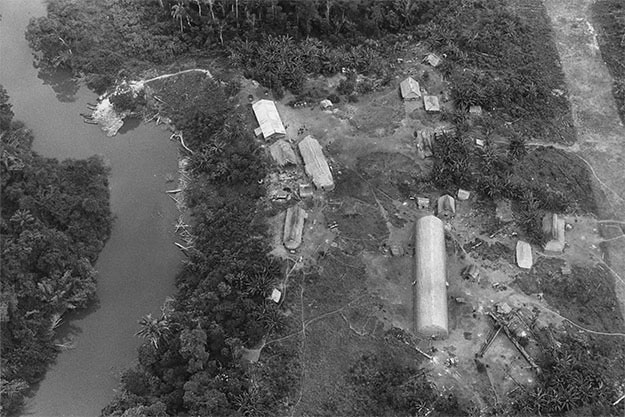
Aerial view of Koatinemo settlement. Ipixuna river, large communal house, post-contact smaller houses and airstrip.
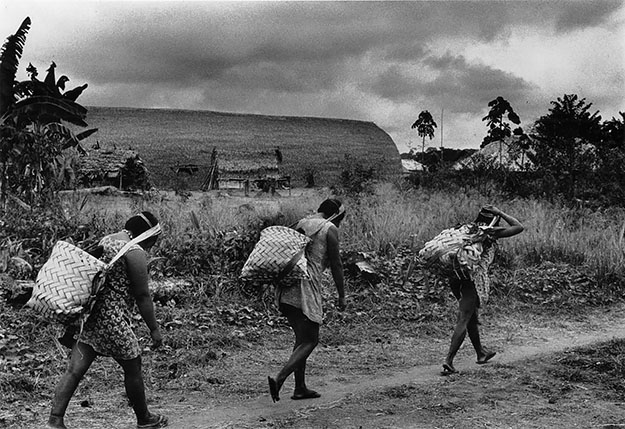
Women returning to village after gathering Brazil nut (castanha do Pará) fruit (Bertholletia excelsa) in the forest. Baskets are carried with thumplines.

Interior of communal house, with large clay pot in center.
Detail of house construction and palm roof.

Young woman in communal house.

Man and his two wives, mother and daughter from a previous husband, in communal house.
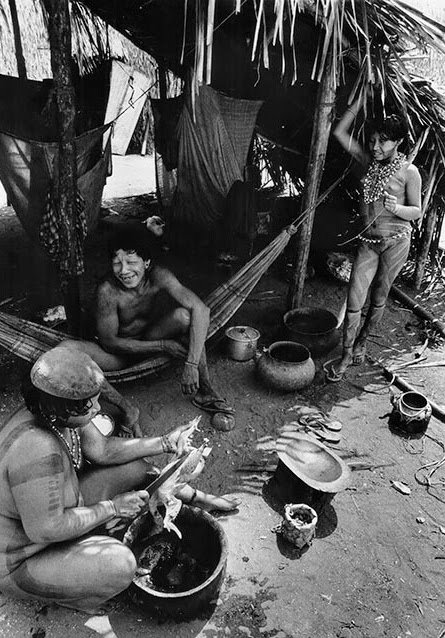
Family life.

Woman making clay pot. Her daughter is coming out of the large communal house. The house is covered with palm thatch.
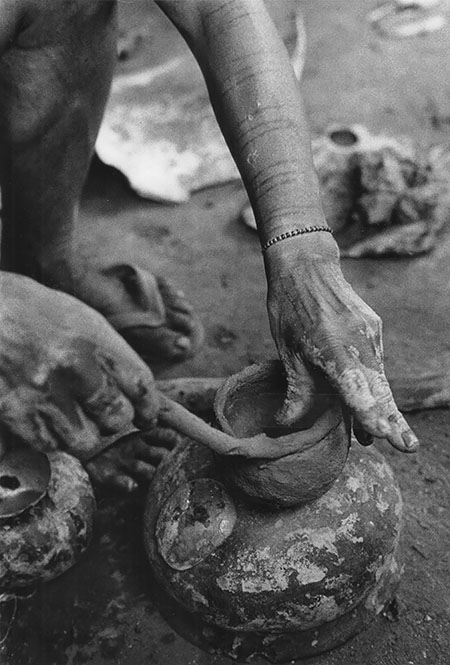
Woman making clay pot, using coil technique.
The Awaeté have developed an elaborate art of symbolic body painting, also applied to pottery.

Main shaman with his two wives, the younger one with body painted with genipa dye. Painting of the lower face and lower legs is common, but painting of the whole body seems to be generally associated with ceremonies or rituals. He is making a necklace, traditionally of monkey teeth, but because of the demand of the Brazilian society (through trade with FUNAI), commercial ones are now made of animal bones.

Detail of body painting in previous picture.

Girl painting her legs with genipa dye.

Girls with body painted with genipa dye. Painting of the lower face and lower legs is common, but painting of the whole body seems to be generally associated with ceremonies or rituals.
Women bathing babies in river.

Portrait of a girl.
Subsistence activities include hunting, collecting, fishing which must have increased by the introduction of canoes by FUNAI, and slash-and-burn cultivation.

Men paddling during a fishing expedition. Canoes were introduced by FUNAI (National Indian Foundation) after contact in 1971.
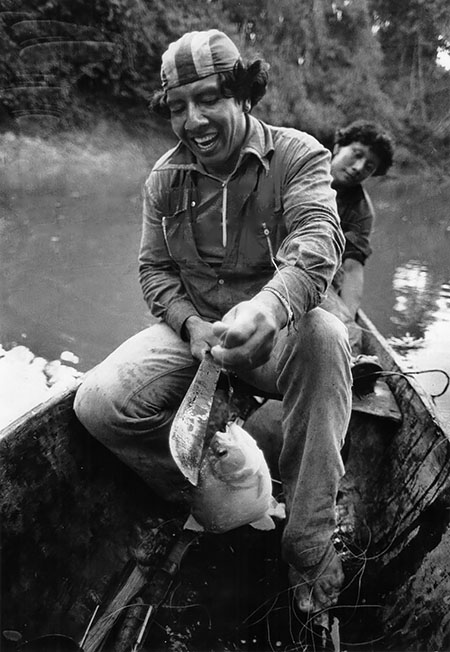
Fishing expedition. Happiness after a good catch!

Hunter with a curassow (mutum) he killed. In 1976 the Awaeté already had shotguns.

Hunter tying land turtles with strap made of inner bark of a tree to immobilize them and for transportation.
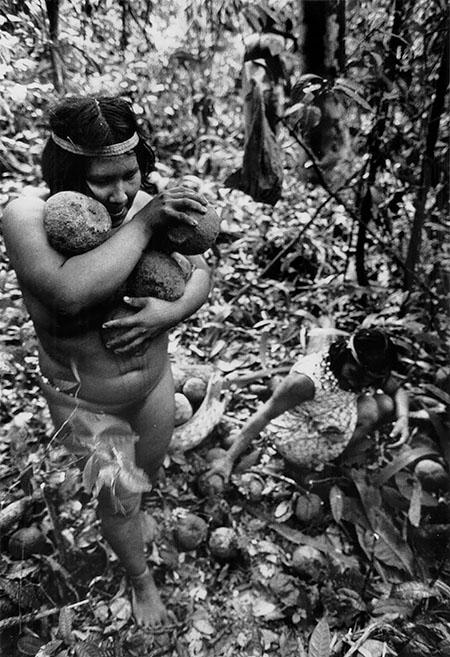
Women gathering Brazil nut (castanha do Pará) fruit (Bertholletia excelsa) in the forest.
Girls harvesting manioc tubers in slash-and-burn garden.
Leaves of varieties of manioc cultivated by Awaeté in slash-and-burn gardens.
Woman spinning cotton grown in slash-and-burn gardens.
PURCHASE of PICTURES: contact me at jjangoux@gmail.com. These pictures are not on my website.
References, links
Bearded Indians of the tropical forest. The Asurini of the Ipiaçava. Anton Lukesch. (book)
Asurini do Xingu – Povos Indígenas do Brasil – Instituto Socioambiental. (more references!)
Preliminary observations on shamanism, curing rituals and propitiatory ceremonies among the Asurini Indians of the middle Xingu in Brazil. Jacques Jangoux. Arquivos de Anatomia e Antropologia, Instituto de Antropologia Professor Souza Marques, 1978. (reprint)
Asurini do Xingu – Awaeté. David J. Phillips.
ASURINI DO XINGU, História e Arte. Regina Müller. Segunda edição, Editora da UNICAMP, 1993. (book)
Belo Monte: como estão os indígenas isolados na área Urina/Itatá? Telma Monteiro, 1915.
O grafismo corporal dos Asurini do Koatinemo. Preservação cultural de um povo indígena. Raimundo Alberto Tavares Ampuero. Universidade de Taubaté. (pdf download)
Asurini capturam garimpeiros – Amazonia Real 2019
